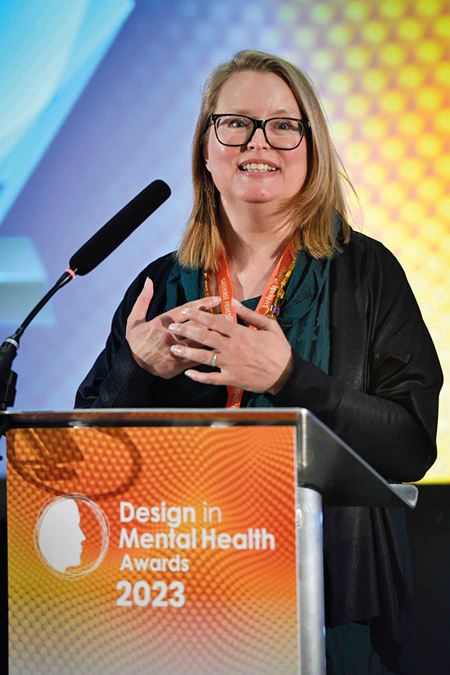
Following the announcement, we spoke to stakeholders and experts from the industry from the public and private sector to find out what the next steps may be…
HANNAH CHAMBERLAIN, CEO, DESIGN IN MENTAL HEALTH NETWORK
“The mental health acute and forensic estate in the NHS is suffering from long term under investment. At the same time, the structure of services has changed, with a requirement to join up, under the ICS system, to create multiple front doors via the community transformation agenda, and to accelerate patients through the acute system in order to meet rising demand. Without buildings that are fit for purpose we will not be able to support people to step up and down effectively to secondary services. This means investment in both the acute, primary and community settings – to have buildings that can deliver the vision in the NHS Long Term Plan. “Acute settings, which take so much of the strain of the rising demand, need to be supported by adequate community and step down environments. They also need to help people to recover a sense of self and form solid plans for social support out of hospital. In MerseyCare, the Life Room project made effective use of an integration between RiO and the social prescribing software Elemental. The project created a space that could function as an acute setting, with multiple supports in place to step up and down, and social care plans integral to the success stories of individual patients. “It is this sort of joined up thinking that needs to be put into play, so that acute settings don’t create revolving door patients with rapid re-entry and a lack of community support. As recent headlines showed, almost 5,000 people per year are re-admitted into acute settings within a month of discharge. Investing in new hospitals is a start, but that on its own does not go far enough. Unless the entire estate is overhauled with a clear strategy to support the Long Term Plan and a revisioning of the role of self management, peer led services, and community and voluntary sector support, the acute services will continue to be disconnected from their settings, and overwhelmed by demand.
PAUL YEOMANS, DIRECTOR, MEDICAL ARCHITECTURE
“The UK has had historically low levels of investment in capital compared to similar countries. This has been made worse in recent years by transfers from the capital budget to the revenue budget, which pays for the day-to-day running of the NHS. With plenty of infrastructure modernisation urgently required, the government’s room for manoeuvre is very limited. The UK public finances are in poor shape with borrowing already at the highest level for 30 years. “With limited scope for major new project investment, there is now a growing appetite for re-evaluating what can be achieved with existing health infrastructure. Not all NHS facilities are appropriate for reuse, so careful appraisal is needed to select the right project. However, given the large amount of poor estate the potential benefits are significant. There are wider sustainability benefits as this approach reduces waste and capitalises on embodied carbon in the existing fabric. “Modest interventions in unloved but functional hospital buildings can deliver a big impact. Small modifications to structure and services can improve flow and functionality, whilst improvements to internal environments have a direct impact on patient and staff perceptions, improving productivity and experience. “More substantial repurposing of buildings can act as an enabler of change, providing for new models of treatment and care where the cost and timescale required for new building would be prohibitive. These projects are sometimes the most challenging and rewarding. From a technical perspective, a project must meet the equivalent environmental standards of a new building; for the designer the objective is to provide a step change in environmental quality for the public, patients and staff. “We need strong leadership, skill and a concerted effort to secure short-term improvements whilst nurturing a long-term positive vision for our healthcare estates. This dual strategy entails building a pipeline of rapid, revenue driven, high impact improvements alongside strategic plans that will underpin a robust and appealing forward vision. New NHS facilities will integrate sustainable design, modern methods of construction, logistical automation and digital technologies to ensure our healthcare infrastructure is fit for the future.”
MATTHEW TAYLOR, CHIEF EXECUTIVE THE NHS CONFEDERATION
“Some of our members have parts of their estate that are barely fit for the 19th century, let alone the 21st, so any future Secretary of State for Health and Social Care must make the physical and digital condition of the NHS a priority, if the health service is to reduce backlogs and get productivity levels to where the government want them to be. “Lack of capital across different care settings, covering digital and physical infrastructure and mental and physical health, is clearly not just leading to missed opportunities to improve productivity, but actively undermining it and causing patient safety issues. Health leaders across England have endless ideas about how capital funding could drive large productivity increases. “Equipping staff with the right tools, and allowing them to operate in safe, modern, optimised environments will improve efficiency, meaning that an increase to the capital budget will help limit the need for growth in revenue spend, relieve pressure on wider NHS finances and services, and put the NHS on the path to longer-term financial sustainability. “This will require a significant increase to the NHS capital budget to make up for years of under-resourcing and repeated raids on capital that has left much of the estate broken. Based on the assessment of health leaders, this will need to be an increase of £6.4bn to take the capital budget to £14.1bn for each year of the next spending review in order to fully address the repairs backlog and realise some of the innovative transformation projects which have previously fallen by the wayside. The next government must grasp the nettle.”
A DEPARTMENT OF HEALTH AND SOCIAL CARE SPOKESPERSON
“We have invested significant sums to upgrade and modernise NHS buildings so staff have the facilities needed to provide worldclass care for patients, including £4.2bn last financial year and £8.4bn over the next two financial years. “Trusts are responsible for prioritising this funding to maintain and refurbish their premises, including the renewal and replacement of equipment. “This is on top of the £3.7bn made available for the first four years of the New Hospital Programme and a further £1.7bn for over 70 hospital upgrades across England alongside a range of nationally funded infrastructure improvements in mental health, urgent and emergency care and diagnostic capacity.”


